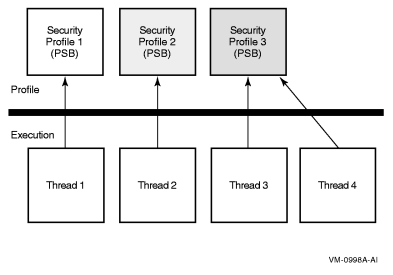Contents of a User's Security Profile
» Table of Contents | » Glossary | » Index |
The profile of a user process or application includes the following elements:
User identification code (UIC) identifying the user
Rights identifiers held by the process
Privileges, if any
OpenVMS Alpha Version 7.2 includes the implementation of thread-level security. This feature, known as per-thread security, allows each execution thread of a multithreaded process to run an independent security profile without impacting the security profiles of other threads in the process.
Security profile information previously contained in various process level data structures and data cells is now stored in a single data structure, the Persona Security Block (PSB), which is then bound to a thread of execution. All associated references within OpenVMS have been redirected accordingly. Every process in the system has at least one PSB that is the natural persona of the process. The natural persona is created during process creation.
Interaction between a thread manager (for example, the thread manager incorporated within HP POSIX Threads Library) and the security subsystem provides for the automatic switching of profiles while threads are scheduled for execution.
The user's security profile (privileges, rights, and identity information) has shifted from the process level to the user thread level. The security information previously stored in several structures (including the Access Rights Block (ARB), Process Control Block (PCB), Process Header Descriptor (PHD), Job Information Block (JIB), and Control (CTL) region fields) has moved to a new Persona Security Block (PSB) data structure and all references are redirected accordingly. OpenVMS no longer uses some of the fields in these structures. The affected fields are now considered obsolete. (See the Obsolete Data Cells and New Location of Security Information table in the HP OpenVMS Release Notes.)
Each process has a persona array containing the addresses of all persona blocks allocated to the process.
The new persona block (PSB) contains the following:
UIC
Persona, and system rights chains
Permanent, authorized, and working privileges
Account name
User name
Auditing flags and counters
The kernel threads block (KTB) points to the persona block for the currently active thread.
In previous versions of OpenVMS, the information that constitutes a user's security profile was bound at the process level, common to all threads of execution within the process. Figure 4-1 “Previous Per-Thread Security Model” illustrates this relationship.
Modifications made to the security profile by one thread are potentially visible to other threads, depending on how the threads perform profile management among themselves.
In OpenVMS Version 7.2, each thread of execution can share a security profile with other threads or have a thread-specific security profile. Figure 4-2 “Per-Thread Security Profile Model” illustrates these relationships.
As is the case in the previous model, modifications to a shared profile are potentially visible to all threads that share the profile. However, modifications made to a thread-specific security profile are only applicable to the particular thread.
The first element of a subject's security profile is the user identification code (UIC). Your UIC tells what system group you belong to and what your unique identification is within that group.
A UIC specification always appears in brackets, but its format can differ. Valid formats include the following:
An alphanumeric UIC consists of a member name and, optionally, a group name:
[member]
or
[group,member]
The group and member names can each contain up to 31 alphanumeric characters, at least one of which is alphabetic. The names can include upper- and lowercase characters A through Z, dollar signs ($), underscores(_), and the numbers 0 through 9.
A numeric UIC contains a group number and a member number:
[group,member]
The group number is an octal number in the range of 1 through 37776; the member number is an octal number in the range of 0 through 177776. You can omit leading zeros when you are specifying group and member numbers. HP reserves group 1 and groups 300--377 for its own use.
The following table illustrates several UICs in proper UIC notation:
| Type of UIC | Example | Meaning |
|---|---|---|
Alphanumeric | [USER,FRED] | Group USER, member FRED |
[EXEC,JONES] | Group EXEC, member JONES | |
[JONES] | Group EXEC, member JONES | |
Numeric | [200,10] | Group 200, member 10 |
[3777,3777] | Group 3777, member 3777 |
Only one user can have the member name JONES; therefore JONES must belong to the EXEC group.
UICs cannot be arbitrarily assigned. A security administrator has to observe the following guidelines when creating them:
Member names must be unique for each user on the system.
No member can participate in more than one UIC group.
These guidelines exist because the system translates a UIC to a 32-bit value that represents a group number and a member number; the high-order 16 bits contain the group number, and the low-order 16 bits contain the member number. When translating an alphanumeric UIC such as [J_JONES], the operating system equates the member part of the alphanumeric UIC to both the group and member parts of a numeric UIC. The resulting 32-bit numeric UIC is kept in the rights database (which is a file containing information about identifiers, their attributes, and holders). For example, you could not have the two UICs [GROUP1,JONES] and [GROUP2,JONES] on the same system because the member JONES can have only one associated numeric UIC. The member name of the alphanumeric UIC is normally the same as the associated login user name.
When you log in to a system, the operating system copies your UIC from your user authorization (UAF) record in the system user authorization file (SYSUAF.DAT) and assigns it to your process. It serves as an identification for the life of the process.
By default, detached processes (created by the DCL command SUBMIT or RUN) and subprocesses (created by the DCL command SPAWN) take the same UICs as their creators. If you have IMPERSONATE privilege, you can create a detached process with a different UIC (by using the /UIC qualifier of the RUN command).
The second element of a subject's security profile is a set of rights identifiers.
A rights identifier represents an individual user or a group of users. Using the Authorize utility (AUTHORIZE), security administrators create and remove identifiers and assign users to hold these identifiers. Rights identifiers can be a temporary way of identifying a group of users because users hold certain identifiers only as long as they are necessary.
The operating system supports several types of rights identifiers. Table 4-1 “Major Types of Rights Identifiers” shows the identifiers that are most commonly used in access control.
Table 4-1 Major Types of Rights Identifiers
| Type | Description | Format | Example |
|---|---|---|---|
Environmental identifiers | Describe different types of users based on their initial entry into the system. | Alphanumeric strings automatically created by the system. See “Types of Logins and Login Classes” for details. | BATCH, NETWORK, INTERACTIVE, LOCAL, DIALUP, REMOTE |
General identifiers | Defined by the security administrator. | Alphanumeric strings of 1 through 31 characters with at least one alphabetic character. Valid characters include numbers 0 through 9, characters A through Z and a through z, the dollar sign ($) and the underscore (_). | SALES, PERSONNEL, DATA_ENTRY, RESERVE_DESK |
UIC identifiers | Based on a user's identification code (UIC), which uniquely identifies a user on the system and defines the group to which the user belongs. | Alphanumeric UICs, with or without brackets. Valid characters are the same as those for a general identifier. | [GROUP1,JONES], [JONES], GROUP1, JONES |
Facility identifiers | Defined by the application. | Same as a general identifier. See the HP OpenVMS Programming Concepts Manual for details. | DBM$MOD_SCHEMA |
In addition to the identifiers listed in Table 4-1 “Major Types of Rights Identifiers”, a system node identifier of the form SYS$NODE_ node_name is created by the system startup procedure (STARTUP.COM in SYS$SYSTEM).
Associated with your process is a rights list that contains all the identifiers granted to it. In addition, there is a system rights list that is shared by all users on the system. The system manager or the system software grants identifiers to the system rights list that are granted to all users currently logged on to the system.
You can display the identifiers for your current process with the SHOW PROCESS command, for example:
|
|
|
|
|
|
Output from this SHOW PROCESS command displays three types of identifiers:
UIC identifier, indicating user Greg is a member of the DOC group
Environmental identifier, indicating user Greg is an interactive user
Environmental identifier, indicating user Greg is logged in locally
General identifier, indicating user Greg is also a member of the SALES group
General identifier, indicating Greg holds the MINDCRIME identifier with the resource attribute so he can charge disk space to the identifier
Environmental identifier, indicating user Greg is working from the ACCOUNTS node
The rights identifiers of a process also appear in audit records. If a security administrator chooses to audit access to objects, then the operating system can produce a record of which users accessed objects and when. Although a single audit record rarely tells very much, the trail of records can, over a period of time, reveal a pattern of behavior that tells a story.
The following audit record shows that user Greg attempted to delete a file but was prevented from doing so because he holds the identifier MINDCRIME. The file 93_FORECAST.DAT has an ACE preventing access by processes with the identifier MINDCRIME. (Relevant lines are Event information, Matching ACE, and Status.)
|
A third (optional) element of a subject's security profile is a set of privileges.
Privileges let you use or perform system functions that ordinarily would be denied to you. Security administrators can grant privileges to users under special circumstances so they can perform necessary tasks without changing existing protection authorizations.
Privileges vary in power. Some allow normal network operations; for example, NETMBX and TMPMBX let you send and receive mail across the network. But others, such as SYSNAM, grant the ability to influence system operations. A user with the SYSNAM privilege can modify the system logical name table.
A user's privileges are recorded in the user's UAF record in a 64-bit privilege mask. When a user logs in to the system, the user's privilege vector is stored in the subject's (process) security profile.
You can use the DCL command SET PROCESS/PRIVILEGES to enable and disable privileges for which you are are authorized, thus controlling the privileges available to the images you run. Example 4-1 “Authorized Versus Default Process Privileges” shows user Puterman has a large number of authorized privileges, which are available for use when necessary, yet Puterman's process runs by default with only two privileges enabled: NETMBX and TMPMBX.
Example 4-1 Authorized Versus Default Process Privileges
|
|
Puterman can enable specific authorized privileges as he needs them; for example, he needs ALLSPOOL to allocate a spooled device and LOG_IO to perform logical I/O operations.

